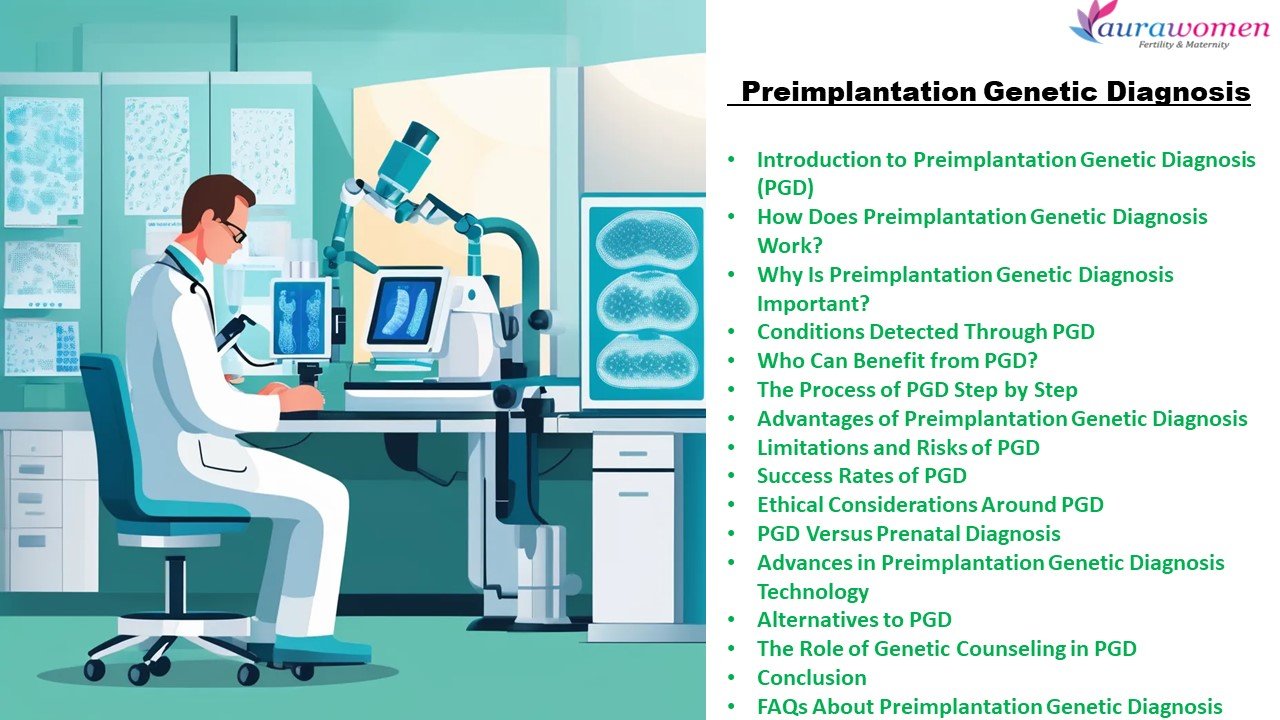
17 Sep Preimplantation Genetic Diagnosis (PGD)
Preimplantation Genetic Diagnosis (PGD) is a groundbreaking medical procedure designed to screen embryos for genetic disorders before they are implanted in the uterus during in vitro fertilization (IVF). This technique helps couples at risk of passing on genetic conditions to ensure that only healthy embryos are selected for pregnancy. Over the years, PGD has revolutionized reproductive medicine by significantly reducing the likelihood of genetic diseases.

How Does Preimplantation Genetic Diagnosis Work?
To understand PGD, it’s important first to grasp the basics of IVF. During IVF, eggs are retrieved from a woman’s ovaries and fertilized with sperm in a laboratory. Once the embryos are formed, PGD is performed to examine them for any genetic abnormalities.
Genetic Screening Techniques
The genetic screening process involves taking a few cells from each embryo and analyzing them for specific genetic markers. The two most common techniques used in PGD are fluorescence in situ hybridization (FISH) and next-generation sequencing (NGS). These methods provide detailed insight into the genetic makeup of the embryos, allowing doctors to select the healthiest ones.
Embryo Selection
After the genetic screening is complete, the healthiest embryos—those free of genetic abnormalities—are selected for transfer to the mother’s uterus. This careful selection process reduces the risk of genetic diseases and increases the chances of a successful pregnancy.
Why Is Preimplantation Genetic Diagnosis Important?
PGD plays a critical role in preventing the transmission of genetic disorders from parents to their offspring. It can detect a wide range of conditions, including those that are life-threatening or severely debilitating.
Reducing the Risk of Genetic Diseases
One of the main reasons couples opt for PGD is to reduce the risk of passing on genetic disorders such as cystic fibrosis, Huntington’s disease, or sickle cell anemia. By screening embryos before implantation, PGD ensures that only embryos without the genetic mutation are implanted, significantly lowering the risk of the child inheriting the disorder.
Screening for Chromosomal Abnormalities
In addition to genetic diseases, PGD can screen for chromosomal abnormalities like Down syndrome, which can affect a child’s development. Identifying these issues early increases the chances of having a healthy baby.
Conditions Detected Through PGD
PGD can detect various genetic and chromosomal conditions, making it a powerful tool for at-risk couples.
Monogenic Disorders
Monogenic disorders are caused by mutations in a single gene, and PGD can screen for a wide variety of these, including conditions like cystic fibrosis and Tay-Sachs disease.
Chromosomal Disorders
Chromosomal disorders occur when there is an abnormal number of chromosomes, leading to conditions such as Down syndrome or Turner syndrome. PGD can detect these abnormalities before embryo implantation.
Sex-Linked Diseases
PGD can also help detect sex-linked diseases, which are passed on through the X or Y chromosomes. This includes conditions like hemophilia, which primarily affects males.
Who Can Benefit from PGD?
PGD is especially beneficial for couples with a known risk of genetic disorders, those who have experienced recurrent miscarriages, or older couples undergoing fertility treatments.
The Process of PGD Step by Step
Ovarian Stimulation and Egg Retrieval
The first step in the PGD process involves stimulating the woman’s ovaries to produce multiple eggs. These eggs are then retrieved during a minor surgical procedure.
Fertilization and Embryo Creation
The retrieved eggs are fertilized with sperm to create embryos. These embryos are allowed to develop for a few days before genetic testing.
Genetic Testing of Embryos
Once the embryos have reached a certain stage of development, a few cells are taken for genetic testing. This step is crucial in identifying healthy embryos.
Embryo Transfer to the Uterus
Finally, the healthiest embryos are selected and transferred to the mother’s uterus, where they will hopefully result in a successful pregnancy.
Advantages of Preimplantation Genetic Diagnosis
PGD offers numerous advantages, particularly for couples at risk of passing on genetic conditions.
Increased Chances of a Healthy Baby
By selecting only the healthiest embryos, PGD increases the likelihood of a healthy pregnancy and a healthy baby.
Improved Success Rates of IVF
Couples using PGD often experience improved success rates with IVF because the risk of implantation failure due to genetic abnormalities is reduced.
Ethical Considerations Around PGD
Despite its many benefits, PGD raises ethical concerns.
Concerns About Designer Babies
One of the most controversial issues surrounding PGD is the fear of creating “designer babies,” where parents could potentially select traits such as eye color or intelligence.
Conclusion
In conclusion, Preimplantation Genetic Diagnosis is a revolutionary tool that helps couples reduce the risk of genetic diseases while improving IVF success rates. As technology advances, PGD will likely play an even bigger role in personalized medicine.
FAQs About Preimplantation Genetic Diagnosis
- How much does PGD typically cost?
PGD can cost between $5,000 and $10,000, depending on the clinic and the complexity of the testing. - Is PGD safe for the baby and the mother?
Yes, PGD is generally considered safe, though there are minimal risks associated with IVF and embryo manipulation. - Can PGD guarantee a healthy baby?
While PGD significantly reduces the risk of genetic disorders, it cannot guarantee a healthy baby as other factors can affect pregnancy and development. - How long does the PGD process take?
The PGD process typically adds about 1-2 weeks to
the overall IVF timeline, as genetic testing requires time to complete before embryo transfer.
- Is PGD covered by insurance?
In most cases, PGD is not fully covered by insurance, though some plans may cover part of the costs, particularly if it’s deemed medically necessary.




No Comments